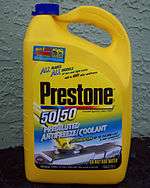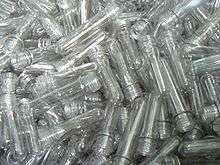Plastic bottle

A plastic bottle is a bottle constructed from plastic. Plastic bottles are typically used to store liquids such as water, soft drinks, motor oil, cooking oil, medicine, shampoo, milk, and ink. The size ranges from very small sample bottles to large carboys.
History
Plastic bottles were first used commercially in 1947, but remained relatively expensive until the early 1960s when high-density polyethylene was introduced.[1] They quickly became popular with both manufacturers and customers due to their lightweight nature and relatively low production and transportation costs compared with glass bottles.[2][3][4] However, the biggest advantage plastic bottles have over glass, is their superior resistance to breakage, in both production and transportation. Except for wine and beer, the food industry has almost completely replaced glass with plastic bottles.
Production

Plastic bottles are formed using a variety of techniques. The choice of material varies depending upon application.
- High Density Polyethylene (HDPE) is the most widely used resin for plastic bottles. This material is economical, impact resistant, and provides a good moisture barrier. HDPE is compatible with a wide range of products including acids and caustics but is not compatible with solvents. It is supplied in FDA-approved food grade. HDPE is naturally translucent and flexible. The addition of color will make HDPE opaque, but not glossy. HDPE lends itself to silk screen decoration. While HDPE provides good protection at below freezing temperatures, it cannot be used with products filled above 160 °F (71 °C) or products requiring a hermetic (vacuum) seal.
- Low Density Polyethylene (LDPE) is similar to HDPE in composition. It is less rigid and generally less chemically resistant than HDPE, but is more translucent. LDPE is used primarily for squeeze applications. LDPE is significantly more expensive than HDPE.
- Polyethylene Terephthalate (PET, PETE or polyester) is commonly used for carbonated beverage, water bottles and many food products. PET provides very good alcohol and essential oil barrier properties, generally good chemical resistance (although acetones and ketones will attack PET) and a high degree of impact resistance and tensile strength. The orienting process serves to improve gas and moisture barrier properties and impact strength. This material does not provide resistance to very high temperature applications—max. temp. 200 °F (93 °C).
- Polyvinyl Chloride (PVC) is naturally clear, has extremely good resistance to oils, and has very low oxygen transmission. It provides an excellent barrier to most gases and its drop impact resistance is also very good. This material is chemically resistant, but it is vulnerable to some solvents. PVC has poor resistance to high temperatures and will distort at 160 °F (71 °C), making it incompatible with hot-filled products. It has attained notoriety in recent years due to potential health risks.
- Polycarbonate (PC) is a clear plastic used to make water and milk bottles. 5 gallon water bottles are the most common examples of PC bottles.
- Polypropylene (PP) is used primarily for jars and closures and provides a rigid package with excellent moisture barrier. One major advantage of polypropylene is its stability at high temperatures, up to 220 °F (104 °C). Polypropylene is autoclavable and offers the potential for steam sterilization. The compatibility of PP with high filling temperatures is responsible for its use with hot fill products. PP has excellent chemical resistance, but provides poor impact resistance in cold temperatures.
- Polystyrene (PS) offers excellent clarity and stiffness at an economical cost. It is commonly used with dry products including vitamins, petroleum jellies, and spices. Styrene does not provide good barrier properties, and exhibits poor impact resistance.
- Fluorine Treated (HDPE) bottles are exposed to fluorine gas in a secondary operation, are similar in appearance to HDPE and have exceptional barrier properties to hydrocarbons and aromatic solvents. Fluorine treated bottles are excellent for use with insecticides, pesticides, herbicides, photographic chemicals, agricultural chemicals, household and industrial cleaners, electronic chemicals, medical cleaners and solvents, citrus products, d-limonene, flavors, fragrances, essential oils, surfactants, polishes, additives, graffiti cleaning products, pre-emergents, stone and tile care products, waxes, paint thinner, gasoline, biodiesel, xylene, acetone, kerosene and more.
- For non-bottle applications, fluorination of plastic can provide compliance with state and federal regulations. An example would be fluorination plastic fuel tanks used for lawn and garden equipment, automobiles, etc.
- Post Consumer Resin (PCR) is a blend of reclaimed natural HDPE (primarily from milk and water containers) and virgin resin. The recycled material is cleaned, ground and recompounded into uniform pellets along with prime virgin material especially designed to build up environmental stress crack resistance. PCR has no odor but exhibits a slight yellow tint in its natural state. This tint can be hidden by the addition of color. PCR is easily processed and inexpensive. However, it cannot come into direct contact with food or pharmaceutical products. PCR can be produced in a variety of recycled content percentages up to 100%.
- K-Resin (SBC) is ideally suited to a wide variety of packaging applications by virtue of its sparkling clarity, high gloss, and impact resistance. K-Resin, a styrene derivative, is easily processed on polyethylene equipment. It is suitable for packaging many products but is specifically incompatible with fats and unsaturated oils or solvents. This material is frequently used for display and point-of-purchase packaging.
- Bioplastic - polymer structures based on processed biological materials rather than petrochemicals. Bioplastics are commonly made from renewable sources like starch, vegetable oil, and less commonly, chicken feathers. The idea behind bioplastic is to create a plastic that has the ability to biodegrade.[5]
Health and environmental issues
There is ongoing concern as to the use of plastics in consumer food packaging solutions, environmental impact of the disposal of these products, as well as concerns regarding consumer safety. Karin Michaels, Associate Professor at Harvard Medical School, suggests that toxins leaching from plastics might be related to disorders such as infertility and cancer in humans.[7]
In the United States, plastic water bottles are regulated by the FDA which also inspects and samples bottled water plants periodically. Plastic water bottle plants hold a low priority for inspection due to a continuously good safety record.[8] In the past, the FDA maintained that there was a lack of human data showing plastics pose health problems, however in January 2010, the FDA reversed its opinion saying they now have concerns about health risks.[7]
Labeling

Plastic bottles are marked at their base with the Resin identification code to indicate the material used:
See also
- Bottle
- In-mould labelling
- List of bottle types, brands and companies
- Packaging
- Plastics
- Plastic pollution
- PET bottle recycling
- Society of the Plastics Industry
- Windowfarm
- Bottle wall
References
- ↑ "The History of soft drink Timeline". Retrieved 2008-04-23.
- ↑ "Plastic vs. Glass - Why Plastic Containers Are Better". Packaging of the World. Retrieved 22 October 2015.
- ↑ "The Advantages of Plastic Bottles". Seattle Pi. Retrieved 22 October 2015.
- ↑ "Benefits of Plastic Packaging". Plastic Packaging. Retrieved 22 October 2015.
- ↑ http://plasticisrubbish.com/2013/03/07/what-is-bioplastic-2/
- ↑ http://www.ebottles.com/resins.htm
- 1 2 "Plastic packaging is injurious to health". thehindubusiness.com. Retrieved 3 May 2015.
- ↑ http://www.fda.gov/Food/FoodborneillnessContaminants/BuyStoreServeSafeFood/ucm077079.htm
Books
- Soroka, W. (2002). Fundamentals of Packaging Technology. IoPP. ISBN 1-930268-25-4
- Yam, K. L. (2009). Encyclopedia of Packaging Technology. 978-0-470-0870
External links
| Wikimedia Commons has media related to Plastic bottles. |
- Plastic Bottle Materials and their Properties
- A guide to UPC label use on plastic bottles including printing
- PET Plastic Recycling
- Plastic Bottle Safety Frequently Asked Questions
| ||||||||||||||||||||||||||
|